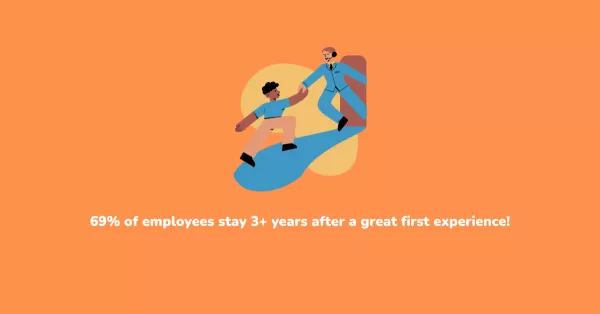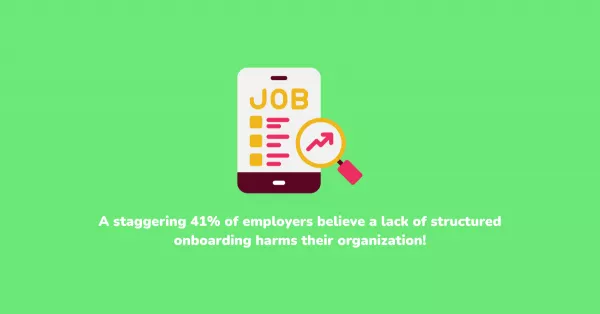Imagine this, you've just landed your dream job. Excitement crackles in the air as you picture yourself diving into new challenges and contributing to a company you believe in. But then, reality sets in. Your first day arrives, and you're greeted with a flurry of paperwork, confusing introductions, and a vague understanding of your role. Days turn into weeks, and you still feel like an outsider, unsure of where you fit in or how to excel.
This scenario, unfortunately, plays out all too often in workplaces across the globe. Companies often underestimate the importance of a strong employee onboarding process. Employee onboarding, in essence, is the roadmap that guides new hires through their initial integration into the company. It's the foundation for building a positive work experience, fostering engagement, and setting the stage for long-term success.
Why Onboarding Matters

Think of onboarding as the bridge between the promise of a new job and the reality of daily work life. A well-designed program goes beyond simply filling out paperwork and familiarizing new hires with the office layout. It's about creating a welcoming and supportive environment where individuals feel valued, equipped, and empowered to contribute meaningfully right from the start.
The benefits of a strong onboarding process are undeniable. Studies show that companies with effective onboarding programs experience:
- Increased employee retention - New hires who go through a structured onboarding program are more likely to stay with the company for the long haul.
- Improved productivity - When employees have a clear understanding of their roles, responsibilities, and expectations, they can hit the ground running and become productive members of the team much faster.
- Enhanced employee engagement - A positive experience fosters a sense of belonging and connection, leading to more engaged and motivated employees.
- Reduced turnover costs - The cost of replacing an employee can be significant. A strong onboarding program helps minimize turnover and its associated financial burden.
The Consequences of Poor Onboarding
On the other hand, a poorly designed onboarding process can have a detrimental impact on both the employee and the company. Common mistakes in onboarding can lead to new hires left feeling confused, unsupported, and unsure of their role are more likely to experience:
- Low morale and disengagement - Feeling lost and unsure of their place within the company can quickly lead to a lack of motivation and a desire to seek employment elsewhere.
- Decreased productivity - Without a clear understanding of their job duties and expectations, new hires may struggle to perform effectively, hindering their overall contribution.
- Increased stress and anxiety - The uncertainty and confusion associated with a poor experience can be a significant source of stress for new employees.
- Negative perception of the company - A bad first impression can leave a lasting impact on a new hire's perception of the company and its culture.
Remember, a strong employee onboarding process isn't just about ticking boxes; it's about creating a positive and lasting impression. It's about investing in your people and laying the foundation for a thriving and engaged workforce.
The Anatomy of a Strong Onboarding Process
A successful and efficient employee onboarding process isn't a one-size-fits-all approach. It's a strategic journey, ideally spanning several weeks or even months, that progressively integrates new hires into the company culture, equips them with the necessary skills and knowledge, and fosters a sense of belonging. Let's delve deeper and explore the key stages of a well-designed onboarding program:
Stage 1: Pre-Boarding
These initiatives ideally begin even before a new hire's first day. This pre-boarding stage focuses on creating a positive first impression and setting the stage for a smooth transition. Here are some key elements to consider:
- Welcome Package - Send a personalized welcome package that includes company swag, essential paperwork to be completed electronically in advance, and a warm welcome message from the team or manager.
- Pre-Onboarding Communication - Maintain clear and consistent communication with the new hires leading up to their start date. Provide an overview of the schedule, answer any questions they may have, and offer resources to help them prepare.
- Tech Setup - Ensure the new hire's computer, phone, and other necessary equipment are set up and ready to go on their first day to minimize technical hiccups.
Stage 2: The First Day
The first day sets the tone for the entire experience. Here's how to create a welcoming and informative first impression:
- Warm Welcome - Organize a warm welcome from the team and key colleagues. Have introductions planned to introduce the new hire to their direct supervisor, team members, and other individuals they'll be collaborating with.
- Company Orientation - Provide a comprehensive overview of the company, its mission, values, and culture. This can include a tour of the office space, introductions to different departments, and an explanation of company policies and procedures.
- Role-Specific Training - Begin tailored training specific to the new hire's role and responsibilities. This may include familiarization with company software, product knowledge sessions, and shadowing experienced colleagues.
- Administrative Tasks - While paperwork is unavoidable, streamline the process by utilizing online forms and allowing new hires to pre-complete some tasks electronically in the pre-boarding stage.
Stage 3: The First Week
The first week allows for deeper immersion into the new hire's role and responsibilities. Here are some crucial aspects to cover:
- Goal Setting - Work collaboratively with the new hire to establish clear and measurable goals for the first month, quarter, and beyond. This fosters a sense of ownership and helps the new hire understand how their role contributes to the company's overall objectives.
- Ongoing Training - Continue providing role-specific training, including in-depth product knowledge sessions, technical skill development, and soft skills training relevant to the position.
- Mentorship Program - Consider assigning a mentor to the new hire. This experienced colleague can provide guidance, answer questions, and offer ongoing support throughout the onboarding process and beyond.
- Team Building Activities - Facilitate opportunities for the new hire to connect with their team members on a personal level. This can include team lunches, coffee breaks, or informal social gatherings.
Stage 4: The First Month
As the first month progresses, the focus shifts towards building confidence, fostering engagement, and increasing the new hire's contribution to the team. Here are some key considerations:
- Project Assignments - Begin assigning the new hire small, manageable projects that allow them to apply their newly acquired skills and knowledge. This fosters a sense of accomplishment and builds confidence in their abilities.
- Performance Feedback - Provide regular and constructive performance feedback to help the new hire identify areas for improvement and celebrate their successes.
- Performance Reviews - Schedule a formal performance review at the end of the first month to discuss progress toward goals, address any concerns, and offer ongoing support.
- Socialization and Integration - Continue to create opportunities for the new hire to interact with colleagues from other departments. This fosters a sense of belonging and encourages collaboration across the organization.
Stage 5: Beyond the First Month
It should be viewed as an ongoing process, not a one-time event. As the new hire settles into their role, it's crucial to provide opportunities for continuous learning and development:
- Access to Resources - Ensure the new hire has access to training materials, online resources, and knowledge-sharing platforms to support their ongoing professional development.
- Development Opportunities - Offer opportunities for professional development, such as attending conferences, workshops, or enrolling in relevant courses. This investment in ongoing learning demonstrates the company's commitment to employee growth and fosters a culture of continuous improvement.
- Career Path Discussions - Schedule regular conversations with the new hire to discuss their career aspirations and identify potential growth opportunities within the company. This demonstrates the company's interest in their long-term development and helps retain top talent.
Beyond the Stages
While the core elements outlined above provide a solid foundation for an effective onboarding program, it's important to consider the specific needs of different roles. Here are some tailoring considerations:
- Management vs. Entry-Level Positions - Management roles may require additional leadership training, delegation skills development, and performance management training. Entry-level positions may benefit from a more hands-on approach with a focus on foundational skills and company processes.
- Technical vs. Non-Technical Positions - Technical roles may require intensive software training and familiarization with specific technical tools. Non-technical roles may focus on developing communication skills, customer service expertise, or industry-specific knowledge.
Remember, a successful onboarding program is flexible and adaptable. By considering the specific needs of each new hire and tailoring the experience accordingly, you can ensure a smooth transition, maximize engagement, and set your new hires up for success.
Evaluating Your Onboarding Process

A strong program isn't static; it requires continuous evaluation and improvement. Let’s look at the tools to assess your current process and identify areas where you can elevate the experience for new hires.
Self-Assessment
The first step is to conduct a thorough self-assessment of your process. Here are some key questions to consider:
- Pre-Boarding - Do you send a personalized welcome package to new hires? Is there clear and consistent communication leading up to their start date? Is all necessary equipment set up and ready for their first day?
- First Day - Does the new hire receive a warm welcome from the team and key colleagues? Is there a comprehensive company orientation planned? Does the first day include role-specific training and streamlined administrative tasks?
- First Week - Do you collaborate with new hires to establish clear goals for them? Do you provide ongoing training programs relevant to their roles? Is there a mentorship program in place to offer guidance and support? Are there opportunities for team building and social interaction?
- First Month - Do you assign new hires manageable projects to allow them to apply their skills? Do you provide regular performance feedback to help them improve? Do you conduct a formal performance review at the end of the month? Are there opportunities for socialization and integration with colleagues from other departments?
- Beyond the First Month - Do new hires have access to resources and tools for continuous learning and development? Are there opportunities for professional development like conferences, workshops, or relevant courses? Do you regularly discuss career aspirations and identify potential growth opportunities within the company?
Gathering Feedback
Beyond self-assessment, actively seeking feedback from new hires is crucial. Here are some ways to capture their valuable insights:
- New Hire Surveys - Develop surveys specifically designed to gather feedback on the experience. This can include questions about the clarity of communication, the quality of training provided, and their overall sense of welcome and support.
- Exit Interviews - Even if a new hire decides to leave the company shortly after induction, conduct exit interviews to understand their experience. Their feedback can be invaluable in identifying areas for improvement.
- Focus Groups - Organize focus groups with recent hires to discuss their induction experience in more detail. This allows you to gain deeper insights into their thoughts, feelings, and suggestions for improvement.
Analyzing Feedback and Identifying Trends
Once you've gathered feedback through self-assessment and new hire input, the next step is to analyze the information and identify trends. Look for patterns in the responses to identify areas where the onboarding program is excelling and areas that require improvement.
Common Challenges
Here are some common induction challenges companies face:
- Lack of Structure and Planning - Without a clear roadmap, the process can feel chaotic and overwhelming for new hires.
- Inconsistent Communication - Mixed messages or a lack of communication can leave new hires feeling confused and unsure of their expectations.
- Limited Training and Development - Inadequate training can hinder a new hire's ability to perform their job effectively and contribute meaningfully.
- Lack of Support - Feeling unsupported and isolated can lead to low morale and a desire to seek employment elsewhere.
By pinpointing specific areas for improvement, you can strategically enhance your program and create a more positive and successful experience for new hires.
A Roadmap for Improvement
Once you've undertaken the crucial step of identifying areas for improvement in your program, it's time to translate insights into action. Here's a comprehensive roadmap to guide you through the process of refining and strengthening your experience:
Prioritizing Improvements
Identifying areas for improvement is just the first step. Now comes the strategic selection of which changes to tackle first. Here are some factors to consider when prioritizing:
- Impact Analysis - Evaluate the potential impact of each change. Focus on improvements that will have the most significant positive effect on new hires' experience, engagement, and productivity. This might involve considering factors like reducing time-to-productivity, improving knowledge retention, or increasing first-year employee satisfaction.
- Resource Allocation - Be realistic about your available resources, both in terms of budget and personnel. Prioritize changes that can be implemented effectively within your current constraints. Consider the potential for leveraging technology or automation to streamline processes.
- Quick Wins - Don't underestimate the power of small, easily implemented changes. Addressing minor pain points early on can demonstrate your commitment to improvement and provide a morale boost for new hires and those involved in the process.
Developing a Revised Plan
Armed with your prioritized list, it's time to refine your program. Here are some key areas you might consider focusing on:
- Structured Learning - Review the effectiveness of your current training modules. Are they engaging? Do they address the essential knowledge and skills required for success in the role? Consider incorporating a variety of learning methods, such as micro-learning modules, interactive simulations, and on-the-job shadowing opportunities.
- Streamlined Processes - Take a critical look at your administrative processes. Can any steps be simplified or automated to better the whole process? Focus on eliminating redundancies and delays that can frustrate new hires during their first few days.
- Mentorship and Buddies - Consider assigning dedicated induction "champions" or mentors to provide support and guidance to new hires. This can be a senior colleague, a team member, or even a recent hire who has successfully transitioned into the role. Buddies can offer informal support and help new hires navigate the company culture and social dynamics.
- Personalized Onboarding - Recognize that one-size-fits-all doesn't work for everyone. Explore ways to personalize the experience based on individual roles, skill sets, and learning preferences. This could involve offering targeted training modules or tailoring initial projects to align with a new hire's strengths and career aspirations.
Communication and Transparency
Once you've finalized the revised induction plan, clear communication is essential:
- Communicate with New Hires - Clearly communicate the changes being made to the program for new hires. This demonstrates that their feedback is valued and shows a proactive approach to improvement.
- Transparency with Existing Staff - Inform existing staff, particularly those involved in the process, about the changes being implemented. This ensures everyone is on the same page and fosters collaboration towards a positive experience.
- Ongoing Feedback Mechanisms - Establish clear and accessible channels for new hires to provide ongoing feedback about their experience. This allows for continuous improvement and ensures the program remains relevant and effective.
Ongoing Monitoring and Evaluation
Remember, an effective program is a living document, not a static one. Here's how to ensure your program stays on track:
- Data-Driven Decisions - Regularly monitor key metrics that reflect the success of your program. This could include metrics like time-to-productivity, employee retention rates, and engagement surveys. Analyze the data to identify areas where the program might be falling short and use the insights to guide further refinements.
- Feedback Loops - Continuously solicit feedback from new hires, managers, and other stakeholders involved in the process. This can be done through formal surveys, exit interviews, or informal discussions.
- Benchmarking - Stay informed about industry best practices and trends in induction. Benchmark your program against those of similar companies to identify areas for improvement and stay ahead of the curve.
Remember, a strong program is an investment in your most valuable asset, your people. By actively evaluating your current approach and implementing strategic improvements, you can create an experience that fosters engagement, boosts retention, and sets your new hires on the path to success.
Why OrangeHRM?
Imagine creating a stress-free experience for every new hire, regardless of group size. OrangeHRM's On/Off-Boarding module empowers you to do just that, with features like customizable templates, task management for everything from induction to visa renewals, and a real-time progress dashboard to identify any roadblocks. Automate tasks, upload information in bulk and receive automatic reminders to ensure a smooth transition for both new hires and departing employees. Streamline your HR processes, create a strong experience, and free up valuable time with OrangeHRM. Book a FREE demo today and see how OrangeHRM can revolutionize your HR operations!
